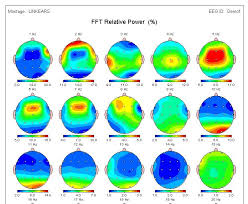Brain Neurofeedback Services Offered At Capital District Neurofeedback
Brain Mapping Assessment (QEEG) | Neurofeedback Brain Training | Neurofeedback Training At Home |
Peak Performance Training For Athletes & Professionals | Therapy/Coaching Services | Other Services
Brain Mapping Assessment (QEEG)

During the roughly one-hour process, a remarkable amount of data is recorded and analyzed. Over 100 points of data are being recorded every second of the QEEG assessment.
Once analyzed, this gives Dr. Cale extraordinary insight into your brain (or your child’s brain) and a map is created that not only tells us where we are now…but more importantly lays out a specific road to follow to make incremental, but massive change in how the brain functions.
The pathway to a more focused, healthier mind is the outcome of this process.
Neurofeedback Brain Training

During individual training sessions, EEG sensors collect your brain’s electrical activity patterns. Through complex technology, your brain activity is compared to a unique target or goal. From there, it is feedback and practice. You get notified immediately (through sounds and/or images on the screen) if your brain reaches your target. All you have to do is pay attention. Like all learning, it takes time and practice. It is important to be patient.

In the initial 20 sessions, you get over 70,000 chances to learn. The latest research in neuroscience and psychology demonstrates that repetition yields changes in brain behavior. This is neuroplasticity. Neuroplasticity is what allows us to reshape our brains to meet (and overcome) the challenges we face. Everyone’s brain is constantly evolving through experience and environment. Repetition of these experiences strengthens existing connections and increases the development of new neuronal connections.
Neurofeedback Training at Home
“Recent innovations allow you to train your brain at home…”
Loading Video...
This has become a more frequent question ever since training adults and children at home using QEEG-driven neurofeedback became viable. While we still create a map, we can use advanced technology to have you trained at home. With this equipment, we can monitor your progress in our office, make adjustments, and change things just as though you are training in our office.
The advantage to you is you can train at home at your leisure, whenever it works for you; you don’t have to come to the office. Secondly, you can train much more frequently because of this. Finally, since you’re not using my staff, the cost is considerably lower.
We find that we get equal to better results with neurofeedback at home because people are very committed to the process. They train regularly, and we can coach them along the way to ensure they stay on top of it, have an accurate reading every time, and get the results they want. So, does home training with neurofeedback work? It’s extraordinary.
But it is important to note that some commercial devices claim to be neurofeedback devices, and in a sense, they are – if you’re comparing a model airplane to something that flies like a jet. These commercial devices look like a band that goes around the head. But they’re very limited in what they can do and have no capacity to train 90% of what we can do with neurofeedback. If you come across such devices for home training, think of them as model airplanes, not neurofeedback jets.
Neurofeedback at home allows you to train efficiently and effectively and achieve results comparable to what we get in the office, regardless of where you live. Neurofeedback is categorized as a level four or five intervention for anxiety disorders, depression, seizures, ADD, and ADHD – not the hyperactive component, for which it is more of a level three, but still very effective. Level five is as high as it gets, which is why we’ve seen remarkable results with home training that match or exceed our in-office results on both adults and children.
A key piece of such outcomes is understanding that neurofeedback is a forward-focused technology. It does not look back; it only trains the brain for better functioning and better-feeling brainwave patterns.
I typically spend at least several sessions with our clients ensuring they understand how to organize their homes and their thought processes. We even have a video training series that goes along with the treatment to maintain this forward-focused approach to change because, just as we can’t drive a car looking in the rearview mirror, we can’t feel better if our brain is stuck in the past.
To get these spectacular results, we have to think about neurofeedback within the context of a very forward-focused discussion about how this technology works and how to organize your thoughts, intent, and life to get the best result possible.
Peak Performance Training for Athletes and Professionals

The difference is that for an athlete, a musician or a professional competing, or intending to compete, on a high level, these negative thoughts can make a critical difference. One moment of hesitation, one moment of doubt…can be a game changer. Literally.

With EEG Neurofeedback, positive thought patterns can be trained to be as natural as the dawning of a new day. Tension and fear-based anxieties can be eliminated, opening the door to optimal performance in many domains of life. Often, it is the frustration, the emotional upset, the loss of complete control over focus that undermines success. As the stakes get higher in any arena, this effect is amplified. Here again, neurofeedback training gives the peak performer an edge with greater emotional control and focus.
Of course, not 100% of treated clients get these remarkable outcomes (and thus, you may not as well), but the literature points to the strong likelihood that athletes, performers and professionals can all find better focus, more calm and enhanced outcomes with EEG
Individual or Family Therapy/Coaching Services

These are frequently an essential component of effectively optimizing every neurofeedback session, particularly in the case of more challenging behavioral issues that require a strong, clear parenting plan to be in place. At times, this may be recommended first, To ensure that the neurofeedback is needed. At times, it is not required after a tight behavioral plan is in maintained at home.
Please be aware that Dr. Cale is only working with individuals and families who are participating in the Neurofeedback training program.



